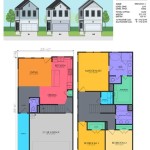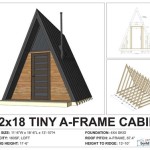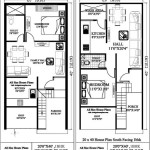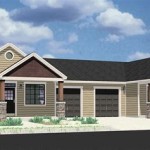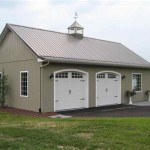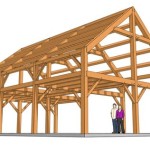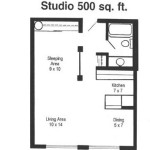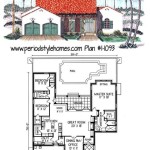Understanding the 3-Bedroom House and Its Floor Plan
The 3-bedroom house remains a highly sought-after housing option for diverse demographics, ranging from young families and first-time homebuyers to downsizing empty nesters and individuals seeking comfortable and manageable living spaces. Its enduring popularity stems from its versatility, affordability, and the balance it strikes between space and maintenance. A critical aspect of a 3-bedroom home is its floor plan, which dictates the flow of movement, functionality of each room, and overall living experience. This article delves into the nuances of a 3-bedroom house, exploring various floor plan considerations and highlighting factors that contribute to its overall appeal.
Unlike larger residences, the design of a 3-bedroom house often requires careful optimization of space. Every square foot needs to be utilized effectively, balancing the need for private sanctuaries (the bedrooms) with communal areas for living, dining, and entertainment. Architects and designers meticulously consider factors such as natural light, traffic patterns, storage solutions, and the specific needs of the target occupants when developing the floor plan. The success of a 3-bedroom house frequently hinges on how well the floor plan addresses these considerations.
Key Considerations in a 3-Bedroom House Floor Plan
The floor plan of a 3-bedroom house isn't merely a blueprint; it's a foundational element that shapes the practicality and enjoyment of the home. Many important factors must be taken into account to create a plan that maximizes space and meet the needs of the occupants. These considerations include room size and proportions, layout, and how well the different zones interact.
Room Size and Proportions: The size of each bedroom, bathroom, kitchen, living area, and other rooms needs to be carefully considered in relation to the overall square footage of the house. A master bedroom should ideally be larger than the other two, offering adequate space for a king-sized bed, dressers, and potentially a sitting area. The secondary bedrooms, typically designed for children or guests, must still be of a size that can comfortably accommodate a bed, desk, and closet. The living area is the heart of the home, and its size depends on the lifestyle of the occupants. Families who enjoy entertaining will naturally require a larger living space. The kitchen's design must correlate with the available space, integrating workspace and accessibility. Bathrooms also need to be appropriately sized. A master bathroom may feature a double vanity, separate shower, and bathtub, while the secondary bathroom may be smaller, with only a shower and single vanity.
Layout and Zoning: The layout refers to how the rooms are arranged in relation to each other. Common layouts include ranch-style (single-story), two-story, and split-level designs. Zoning involves the strategic placement of rooms based on their function and noise level. For instance, bedrooms are generally grouped together in a quieter zone of the house, often separated from the living area and kitchen. This zoning helps ensure privacy and reduces disturbances during sleep. The kitchen and dining area are typically positioned near each other for ease of food preparation and serving. The living area is often located near the entrance of the house, providing a welcoming space for guests.
Circulation and Flow: Effective traffic flow ensures that occupants can move easily and efficiently through the house without encountering bottlenecks or awkward transitions. Hallways should be wide enough to accommodate multiple people passing at the same time. The path from the bedrooms to the bathrooms should be direct and convenient, especially for children. The kitchen layout should minimize steps between the refrigerator, sink, and stovetop (often referred to as the "work triangle"). The placement of doors and windows also impacts circulation. Doors that swing into high-traffic areas can obstruct movement, while strategically placed windows can illuminate hallways and reduce the need for artificial lighting.
Common 3-Bedroom House Floor Plan Styles
The architectural style of a 3-bedroom house greatly influences its floor plan. Different architectural styles offer distinct layouts and spatial arrangements, catering to varying preferences and lifestyle needs. These range from open-concept layouts that prioritize communal spaces to more traditional designs with clearly defined rooms.
Ranch-Style: The ranch-style 3-bedroom house is typically a single-story dwelling with a long, low profile. This style is known for its open floor plans and seamless indoor-outdoor connection. The bedrooms are usually located on one side of the house, while the living area, kitchen, and dining area are on the other. Ranch-style homes are particularly suitable for individuals with mobility issues, as there are no stairs to navigate. These plans often feature a large picture window in the living room, providing ample natural light and panoramic views of the surrounding landscape. A popular variation of the ranch-style is the rambler, which usually has a larger footprint and offers more spacious living areas.
Two-Story: Two-story 3-bedroom houses maximize vertical space, making them ideal for smaller lots. Typically, the ground floor accommodates the living area, kitchen, dining area, and sometimes a half-bathroom (powder room). The bedrooms are usually located on the upper floor, providing more privacy and separation from the main living areas. Two-story homes are often more energy-efficient than ranch-style homes because they have a smaller roof area, which reduces heat loss in the winter and heat gain in the summer. The staircase serves as a central element, connecting the two floors and influencing the overall layout. Some two-story plans include a master suite on the ground floor, offering convenience and accessibility.
Open-Concept: Open-concept floor plans combine the living area, kitchen, and dining area into one large, unified space. This design promotes social interaction and creates a sense of spaciousness. Open-concept plans are popular among families and individuals who enjoy entertaining. The lack of walls allows for better flow of natural light, making the house feel brighter and more inviting. However, open-concept plans require careful consideration of furniture placement and zoning to define separate functional areas within the larger space. Noise control can also be a challenge in open-concept homes, as sound travels freely between the different areas.
Split-Level: Split-level 3-bedroom houses feature multiple levels connected by short flights of stairs. This design can be advantageous for sloping lots, as it allows the house to follow the contours of the land. Typically, one level contains the living area and kitchen, another level contains the bedrooms, and a third level may contain a family room or recreation room. Split-level homes offer a good balance of privacy and communal space. However, the multiple levels can be challenging for individuals with mobility issues.
Optimizing Space and Functionality in a 3-Bedroom Plan
Even with a well-designed floor plan, clever strategies are often required to fully optimize the available space and enhance the functionality of a 3-bedroom house. Maximizing storage, integrating flexible spaces, and creating outdoor living areas can significantly improve the overall living experience.
Storage Solutions: Ample storage is essential in any home, but it's particularly important in a 3-bedroom house where space is often at a premium. Built-in shelving, cabinets, and drawers can maximize storage without taking up valuable floor space. Closets should be well-organized with adjustable shelves and hanging rods to accommodate different types of clothing and accessories. Under-bed storage containers can provide additional space for storing seasonal items or extra bedding. Attic and basement spaces can also be utilized for storage, provided they are properly insulated and ventilated. In the kitchen, consider installing pull-out shelves in the pantry and cabinets to make it easier to access items stored in the back. Vertical storage solutions, such as pot racks and spice racks, can free up counter space.
Flexible Spaces: Creating spaces that can serve multiple functions is a smart way to maximize the utility of a 3-bedroom house. A guest bedroom can double as a home office or study. A formal dining room can also be used as a playroom for children. A finished basement can be transformed into a family room, home theater, or gym. Furniture that can be easily reconfigured, such as sectional sofas and folding tables, can also help create flexible spaces. Consider incorporating a "mudroom" area near the entrance of the house to provide a space for storing shoes, coats, and backpacks. This helps keep the main living areas clean and clutter-free.
Outdoor Living Areas: Extending the living space to the outdoors can significantly enhance the enjoyment of a 3-bedroom house. A patio or deck can provide a space for outdoor dining, entertaining, or simply relaxing. A covered porch can offer protection from the elements, allowing you to enjoy the outdoors even on rainy days. Landscaping can also play a role in creating an inviting outdoor space. Consider planting trees, shrubs, and flowers to create a sense of privacy and tranquility. A well-maintained lawn can provide a space for children to play. An outdoor kitchen or barbeque area can make outdoor entertaining more convenient. Incorporating outdoor lighting can extend the usability of the outdoor space into the evening hours.
In summary, the design and execution of a 3-bedroom house floor plan require careful consideration of numerous factors, from room size and layout to storage solutions and outdoor living spaces. The key is to optimize every square foot to create a functional, comfortable, and enjoyable living environment that meets the needs of the occupants.

Simple 3 Room House Plan S 4 Nethouseplans

3 Bedroom House Design 2024 Beautiful Plans

Simple Yet Elegant 3 Bedroom House Design Shd 2024031 3da

3 Bedroom House Plan Examples

3 Bedroom Bali House Plan B100an Inhouseplans Com

3 Bedroom House Plans Home Designs Nethouseplans

3 Bedroom House Plans Your Guide To Perfect Home Design 2024

3 Bhk House Plan For Perfect Home Construction Jk Cement

3 Bedroom House Plan With Images How To Choose The Right

3 Bedroom Apartment House Plans

